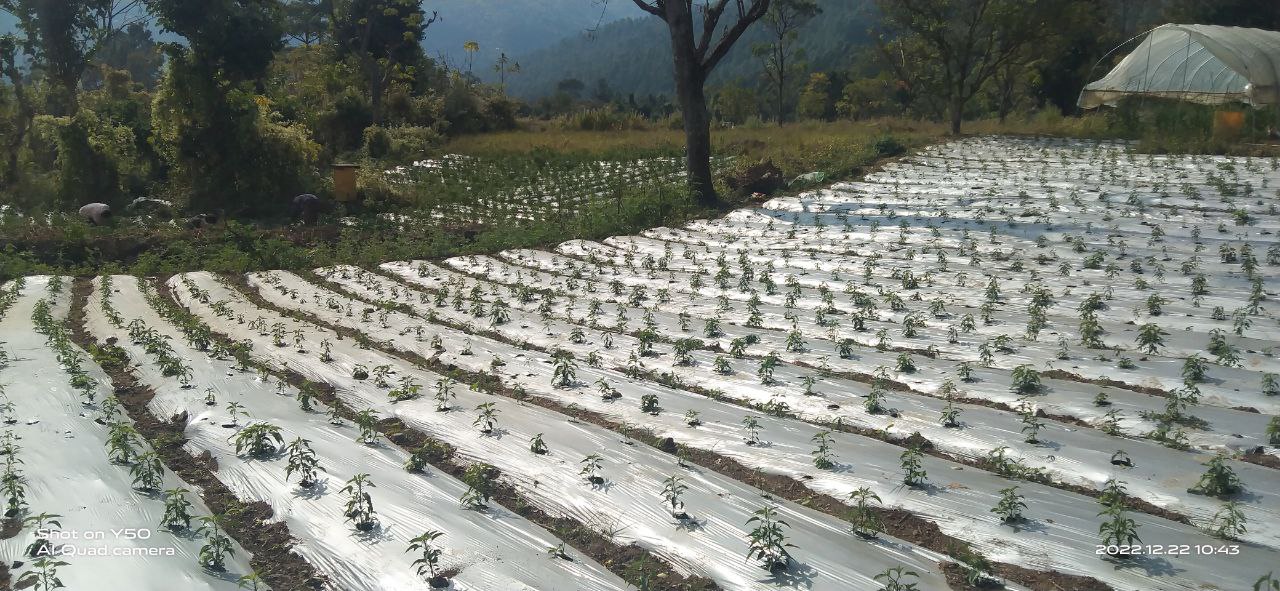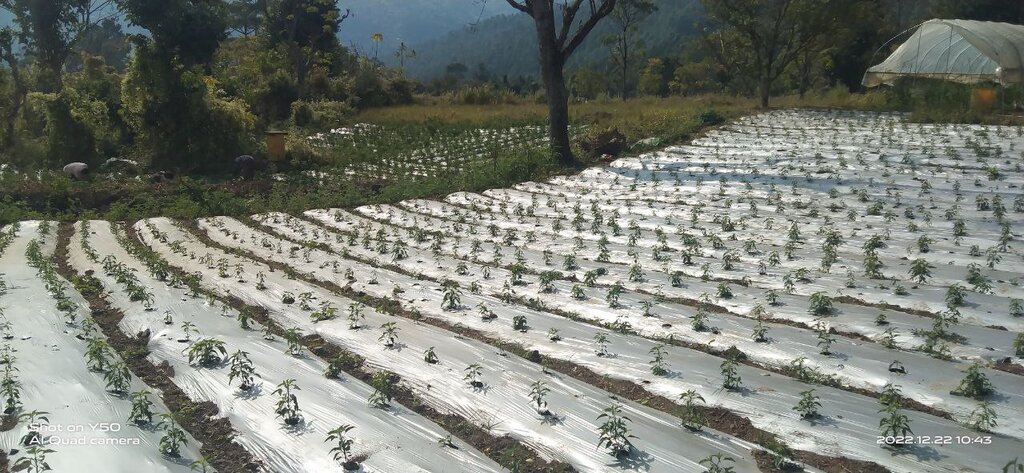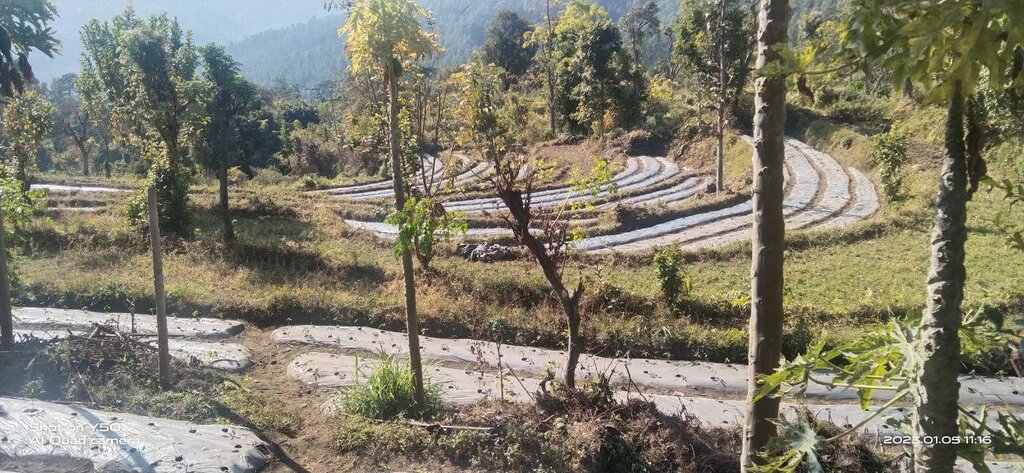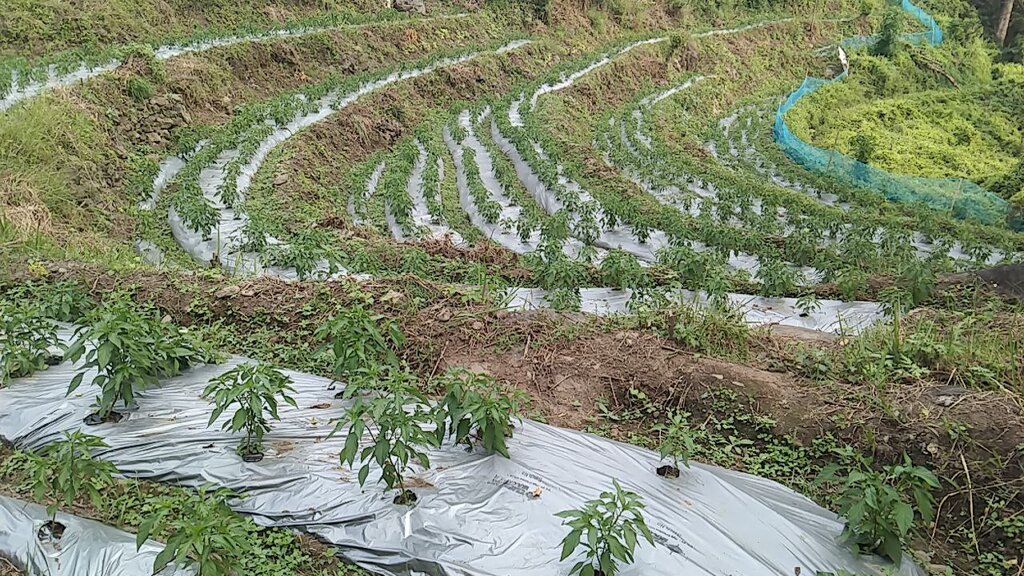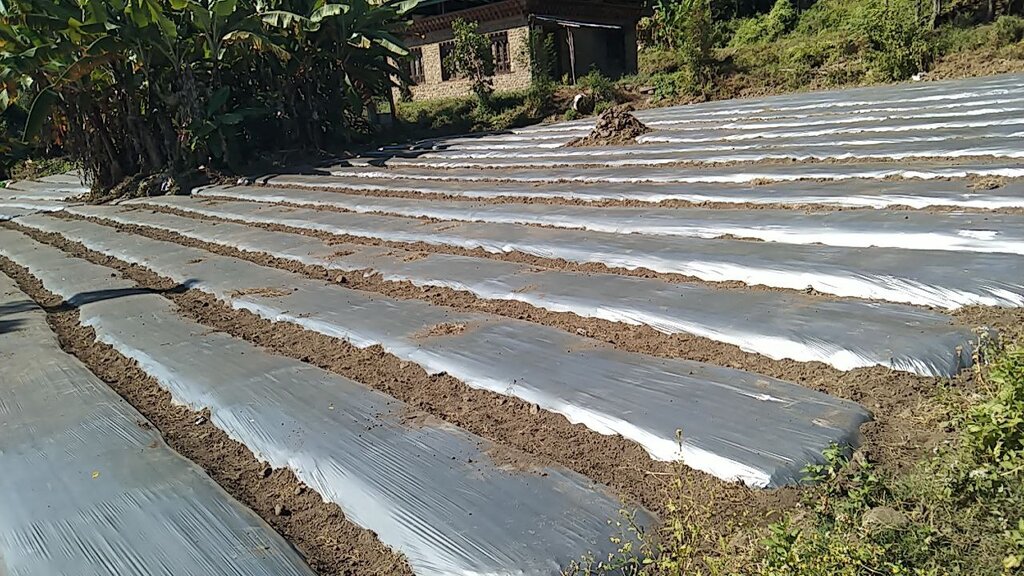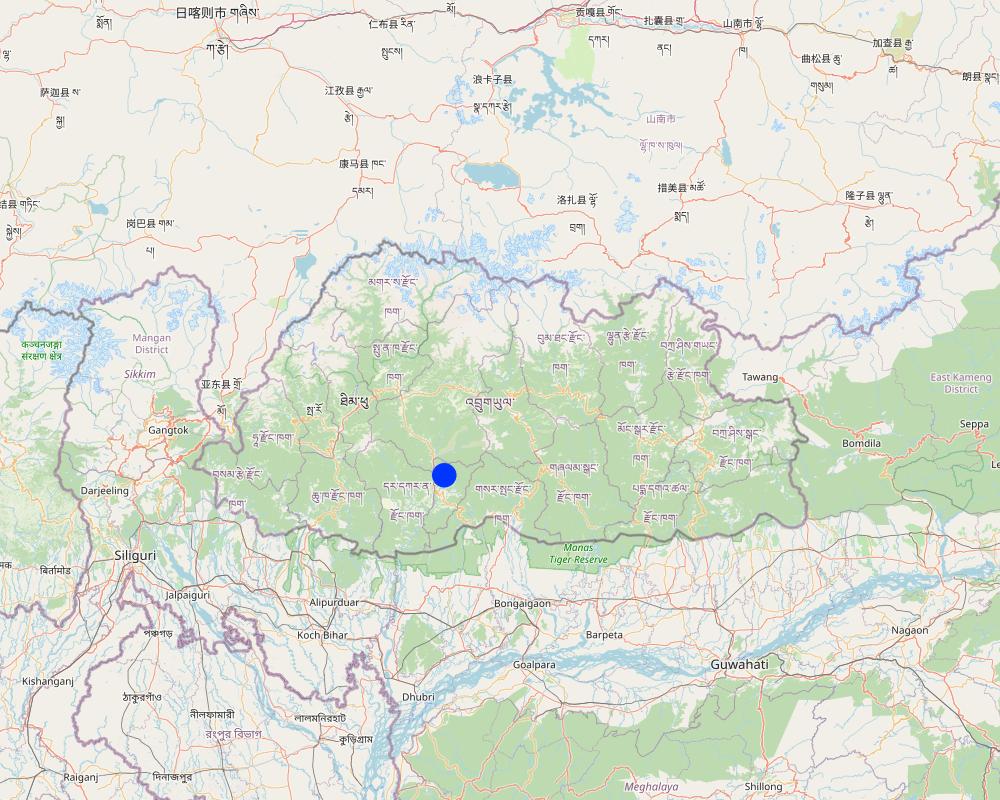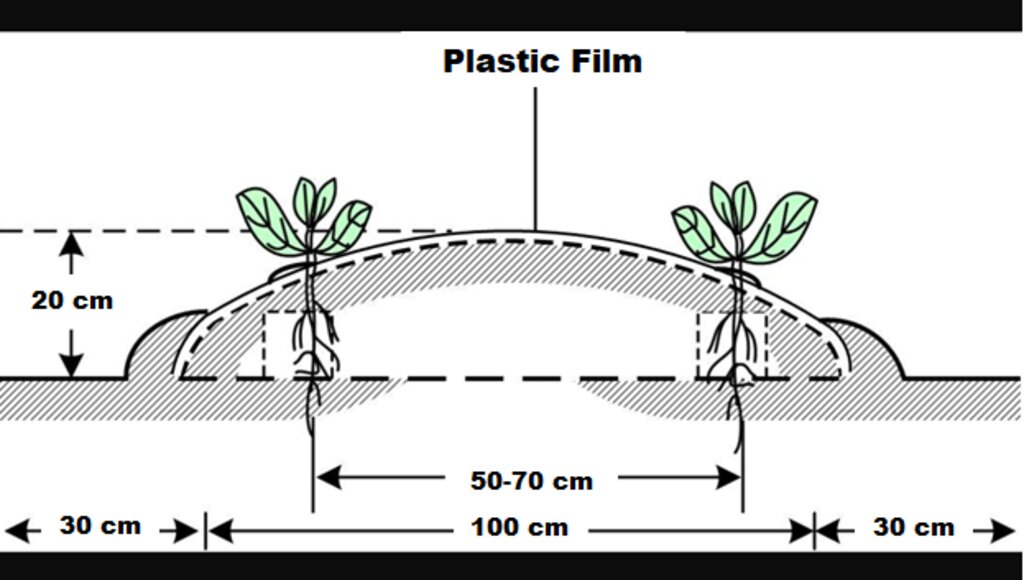Plastic mulching for cash crops [不丹]
- 创建:
- 更新:
- 编制者: Tshering Yangzom
- 编辑者: Kuenzang Nima
- 审查者: William Critchley, Rima Mekdaschi Studer, Joana Eichenberger
Nyuel Thok Nang Chhu Sho Thing Ni (དངུལ་ཐོག་ནང་ཆུ་ཤོག་ཐིང་ནི།)
technologies_6864 - 不丹
查看章节
全部展开 全部收起1. 一般信息
1.2 参与该技术评估和文件编制的资源人员和机构的联系方式
关键资源人
土地使用者:
Rai Pratap Singh
不丹
有助于对技术进行记录/评估的项目名称(如相关)
Strengthening national-level institutional and professional capacities of country Parties towards enhanced UNCCD monitoring and reporting – GEF 7 EA Umbrella II (GEF 7 UNCCD Enabling Activities_Umbrella II)有助于对技术进行记录/评估的机构名称(如相关)
National Soil Services Center, Department of Agric (National Soil Services Center, Department of Agric) - 不丹1.3 关于使用通过WOCAT记录的数据的条件
编制者和关键资源人员接受有关使用通过WOCAT记录数据的条件。:
是
1.4 所述技术的可持续性声明
这里所描述的技术在土地退化方面是否存在问题,导致无法被认为是一种可持续的土地管理技术?:
否
注释:
Mulching in agriculture helps conserve moisture, prevent water and wind erosion, control weeds, and regulate soil temperature. While it has these benefits, it also poses environmental concerns related to soil contamination and waste accumulation. Plastic mulches are a significant source of microplastic pollution in agricultural soils. The residual microplastics in the soil negatively affect soil health. Used plastic mulches are eventually burned and the burning releases greenhouse gases, contributing to climate change and global warming. Additionally, the residues left behind after burning plastic mulches can persist in the soil for extended periods thereby contaminating the soil. Though mulching helps increase crop yields, it has negative effects on the natural environment and thus the use of mulching necessitates careful consideration.
2. SLM技术的说明
2.1 技术简介
技术定义:
Plastic mulching comprises thin plastic sheets laid out on raised soil surfaces around plants to help conserve soil moisture, prevent water and wind erosion, control weeds, and regulate soil temperature. It is used in agriculture to increase crop yields. However, there are environmental concerns about soil contamination and waste disposal.
2.2 技术的详细说明
说明:
Plastic mulching is a widely used agricultural practice in Bhutan, primarily employed in the cultivation of cash crops. Farmers have adopted plastic mulching to enhance crop production and address specific agricultural challenges. It allows farmers to optimize water usage by reducing evaporation and maintaining soil moisture levels, which is crucial in regions where water resources are limited. It also helps suppress weed growth, minimizing competition for nutrients and ensuring healthier crop growth. Additionally, the regulation of soil temperature through plastic mulching can extend the growing season and improve crop quality and yields. These benefits are particularly valuable in Bhutan's mountainous terrain and varied climatic conditions.
However, the application of plastic mulching can have both direct and indirect impacts on the natural environment. Improper disposal or management of plastic mulch can lead to environmental pollution, including soil contamination and plastic waste accumulation. Therefore, sustainable practices and appropriate waste management techniques are crucial to minimize the potential negative effects on the natural environment.
Plastic mulching serves several purposes and functions in agricultural practices. One of its primary functions is moisture conservation, as it helps prevent water evaporation from the soil surface by acting as a barrier. Additionally, plastic mulch controls weeds by blocking sunlight and inhibiting weed seed germination, reducing competition for nutrients. Another important function is soil temperature regulation, as plastic mulching traps heat from the sun, raising soil temperatures in cooler climates and promoting faster plant growth. Overall, plastic mulch contributes to enhanced crop performance.
Furthermore, it helps prevent soil erosion by protecting the soil surface from wind and water erosion, thus maintaining soil structure and fertility, and creating a barrier between plants and the soil, reducing the risk of soil-borne pests and diseases affecting the crops. It can also deter certain pests by disrupting their habitat and limiting access to plants.
Plastic mulching involves the use of thin sheets or films made of polyethylene or similar materials, which come in various colours and thicknesses. Manual tools are utilized to lay the sheets evenly over the prepared soil. Before laying the plastic mulch, the soil is typically ploughed, levelled, raised, and cleared of debris to create a smooth surface. To prevent displacement by wind or other factors, the plastic mulch needs to be securely anchored to the ground. Plastic mulching can be combined with drip irrigation systems to provide water and nutrients directly to the plant roots.
Some specific advantages pointed out by the land user include the opportunity to achieve higher returns on agricultural investments. It reduces the need for manual weeding or herbicide application, saving time, labour, and resources. Additionally, it reduces the frequency of irrigation. It also extends the growing season expanding options and potential profits. There are many advantages of mulching but there are some serious disadvantages of the technology. Plastic mulching poses environmental concerns related to soil contamination and waste accumulation. Plastic mulches are a significant source of microplastic pollution in agricultural soils and these microplastics negatively affect soil health. The disposal of plastic mulches is a challenge as recycling options are limited resulting in waste accumulation on farms. These accumulated wastes are eventually burned and release greenhouse gases, contributing to climate change and global warming. Additionally, the residues left behind after burning plastic mulches can persist in the soil for extended periods thereby contaminating the soil. Also, the cost of purchasing plastic mulch can prove to be too high for farmers if the land area is huge. Though mulching helps increase crop yields, it has negative effects on the natural environment - thus the use of mulching necessitates careful consideration.
2.3 技术照片
2.5 已应用该技术的、本评估所涵盖的国家/地区/地点
国家:
不丹
区域/州/省:
Sergithang, Tsirang
具体说明该技术的分布:
- 均匀地分布在一个区域
如果不知道精确的区域,请注明大致覆盖的区域:
- < 0.1 平方千米(10 公顷)
技术现场是否位于永久保护区?:
否
注释:
The land user uses plastic mulching on 1 acre of land for chili production.
Map
×2.6 实施日期
注明实施年份:
2018
2.7 技术介绍
- It was introduced by the gewog Agriculture Extension Officer and through exposure to social media.
3. SLM技术的分类
3.1 该技术的主要目的
- 改良生产
- 创造有益的经济影响
3.2 应用该技术的当前土地利用类型
同一土地单元内混合使用的土地::
是
具体说明混合土地使用(作物/放牧/树木):
- 农林业

农田
- 一年一作
- 乔木与灌木的种植
年作 - 具体指明作物:
- 谷物类 - 玉米
- 谷类 - 水稻(湿地)
- 根/块茎作物 - 土豆
- 蔬菜 - 叶菜(色拉、卷心菜、菠菜和其他)
- 蔬菜 - 香瓜、南瓜、南瓜或葫芦
- 蔬菜 - 根茎类蔬菜(胡萝卜、洋葱、甜菜等)
乔木和灌木种植 - 指定作物:
- 鳄梨
- 水果、其他
- 芒果、山竹果、番石榴
每年的生长季节数:
- 2
采用间作制度了吗?:
是
如果是,说明哪些作物是间作的:
Vegetable crops are intercropped for self-consumption.
采用轮作制度了吗?:
是
如果是,请具体说明:
Vegetable crops are rotated.

森林/林地
- (半天然)天然森林/林地
以上的树木是落叶树还是常绿树?:
- 混合落叶或常绿
产品和服务:
- 薪材
3.3 由于技术的实施,土地使用是否发生了变化?
由于技术的实施,土地使用是否发生了变化?:
- 否(继续问题3.4)
3.4 供水
该技术所应用土地的供水:
- 混合雨水灌溉
注释:
The land users of Sergithang face water shortage problems.
3.5 该技术所属的SLM组
- Weed management
3.6 包含该技术的可持续土地管理措施

其它措施
具体说明:
Plastic mulching may fall under structural measures.
3.7 该技术强调的主要土地退化类型

土壤水蚀
- Wt:表土流失/地表侵蚀

土壤风蚀
- Et:表土流失

生物性退化
- Bp:害虫/疾病增加,捕食者减少

水质恶化
- Ha:干旱化
- Hs:地表水良变化
3.8 防止、减少或恢复土地退化
具体数量名该技术与土地退化有关的目标:
- 防止土地退化
- 减少土地退化
注释:
Plastic mulching prevents soil and water erosion and conserves soil mositure.
4. 技术规范、实施活动、投入和成本
4.1 该技术的技术图纸
技术规范(与技术图纸相关):
This diagram shows a cross-section of a raised bed using plastic mulching. The plants grow through the punctured holes in the plastic. The length of the bed varies from farm to farm and is 1 m wide and spaced 30 cm apart (bed-bed spacing) for easy access/movement. The bed is usually raised to 20 cm in height. The planting distance shown in the diagram is for chilies, 50-70 cm. The distances will vary according to the crop/variety.
作者:
Thinley Penjor Dorji
日期:
20/07/2023
4.2 有关投入和成本计算的一般信息
具体说明成本和投入是如何计算的:
- 每个技术区域
注明尺寸和面积单位:
1 acre
其它/国家货币(具体说明):
Ngultrum
如相关,注明美元与当地货币的汇率(例如1美元=79.9巴西雷亚尔):1美元=:
82.1
注明雇用劳工的每日平均工资成本:
Nu 400
4.3 技术建立活动
| 活动 | 时间(季度) | |
|---|---|---|
| 1. | Field preparation (tilling) | Winter |
| 2. | Field preparation (rotary tilling) | Winter |
| 3. | Manure application | Winter |
| 4. | Bed preparation | Winter |
| 5. | Laying of plastic mulch | Winter |
| 6. | Making holes in the plastic | Winter |
| 7. | Transplantation | Winter |
4.4 技术建立所需要的费用和投入
| 对投入进行具体说明 | 单位 | 数量 | 单位成本 | 每项投入的总成本 | 土地使用者承担的成本% | |
|---|---|---|---|---|---|---|
| 劳动力 | Field preparation (tilling) | Person/day | 5.0 | 400.0 | 2000.0 | 100.0 |
| 劳动力 | Manure application and rotary tilling | Person/day | 8.0 | 400.0 | 3200.0 | 100.0 |
| 劳动力 | Bed preparation, laying of plastic mulch and making holes | Person/day | 12.0 | 400.0 | 4800.0 | 100.0 |
| 劳动力 | Transplantation | Person/day | 8.0 | 400.0 | 3200.0 | 100.0 |
| 设备 | Power tiller (tilling) | Per day | 1.0 | 2500.0 | 2500.0 | 100.0 |
| 设备 | Power tiller (rotary tilling) | Per day | 1.0 | 2500.0 | 2500.0 | 100.0 |
| 植物材料 | Seeds | Packet | 5.0 | 15.0 | 75.0 | 100.0 |
| 施工材料 | Plastic mulch | Rolls | 4.0 | 2800.0 | 11200.0 | 100.0 |
| 其它 | Food and Refreshment | per person | 33.0 | 350.0 | 11550.0 | 100.0 |
| 技术建立所需总成本 | 41025.0 | |||||
| 技术建立总成本,美元 | 499.7 | |||||
4.5 维护/经常性活动
注释:
No maintenance work has been carried out.
4.6 维护/经常性活动所需要的费用和投入(每年)
如果您无法分解上表中的成本,请估算维护该技术所需要的总成本。:
29823.0
注释:
The plastic mulch is reused and hence there is no expenditure on the plastic mulches.
4.7 影响成本的最重要因素
描述影响成本的最决定性因素:
Higher cost of plastic mulching and hiring a power tiller.
5. 自然和人文环境
5.1 气候
年降雨量
- < 250毫米
- 251-500毫米
- 501-750毫米
- 751-1,000毫米
- 1,001-1,500毫米
- 1,501-2,000毫米
- 2,001-3,000毫米
- 3,001-4,000毫米
- > 4,000毫米
有关降雨的规范/注释:
Falls under Humid Sub-tropical Zone with an annual rainfall of 1200-2500 mm
注明所考虑的参考气象站名称:
The rain estimate has been derived based on the agro-ecological zone (AEZ) the area falls under. Bhutan is divided into AEZs (source: https://www.fao.org/3/ad103e/AD103E02.htm).
农业气候带
- 潮湿的
Bhutan has six AEZs. The wet sub-tropical zone is from 150 to 600 m, followed by the humid sub-tropical zone from 600 to 1,200 m. The dry sub-tropical zone starts at 1,200 m and extends to 1,800 m, followed by the warm temperate zone, which reaches 2,600 m. The cool temperate zone lies between 2,600 and 3,600 m and, finally, the alpine zone between 3,600 m and 4,600 m.
5.2 地形
平均坡度:
- 水平(0-2%)
- 缓降(3-5%)
- 平缓(6-10%)
- 滚坡(11-15%)
- 崎岖(16-30%)
- 陡峭(31-60%)
- 非常陡峭(>60%)
地形:
- 高原/平原
- 山脊
- 山坡
- 山地斜坡
- 麓坡
- 谷底
垂直分布带:
- 0-100 m a.s.l.
- 101-500 m a.s.l.
- 501-1,000 m a.s.l.
- 1,001-1,500 m a.s.l.
- 1,501-2,000 m a.s.l.
- 2,001-2,500 m a.s.l.
- 2,501-3,000 m a.s.l.
- 3,001-4,000 m a.s.l.
- > 4,000 m a.s.l.
说明该技术是否专门应用于:
- 不相关
5.3 土壤
平均土层深度:
- 非常浅(0-20厘米)
- 浅(21-50厘米)
- 中等深度(51-80厘米)
- 深(81-120厘米)
- 非常深(> 120厘米)
土壤质地(表土):
- 中粒(壤土、粉土)
土壤质地(地表以下> 20厘米):
- 中粒(壤土、粉土)
表土有机质:
- 高(>3%)
如有可能,附上完整的土壤描述或具体说明可用的信息,例如土壤类型、土壤酸碱度、阳离子交换能力、氮、盐度等。:
Moisture content-4.46%
Organic matter-5.85 %
Organic carbon-3.40%
pH-6.15
Electrical conductivity-853.00 µs/cm
Nitrogen-0.17
Phosphorus-1.92
Potassium-198.73 mg/100ml
Soil texture-Silt Clay Loam
5.4 水资源可用性和质量
地下水位表:
5-50米
地表水的可用性:
中等
水质(未处理):
良好饮用水
水质请参考::
地表水
水的盐度有问题吗?:
否
该区域正在发生洪水吗?:
否
5.5 生物多样性
物种多样性:
- 中等
栖息地多样性:
- 中等
5.6 应用该技术的土地使用者的特征
定栖或游牧:
- 定栖的
生产系统的市场定位:
- 混合(生计/商业)
非农收入:
- 低于全部收入的10%
相对财富水平:
- 平均水平
个人或集体:
- 个人/家庭
机械化水平:
- 手工作业
- 机械化/电动
性别:
- 男人
土地使用者的年龄:
- 中年人
5.7 应用该技术的土地使用者使用的平均土地面积
- < 0.5 公顷
- 0.5-1 公顷
- 1-2 公顷
- 2-5公顷
- 5-15公顷
- 15-50公顷
- 50-100公顷
- 100-500公顷
- 500-1,000公顷
- 1,000-10,000公顷
- > 10,000公顷
这被认为是小规模、中规模还是大规模的(参照当地实际情况)?:
- 小规模的
注释:
1 acre or 0.404 ha
5.8 土地所有权、土地使用权和水使用权
土地所有权:
- 个人,有命名
土地使用权:
- 个人
用水权:
- 社区(有组织)
土地使用权是否基于传统的法律制度?:
是
具体说明:
The land use rights in Bhutan are based on a traditional legal system guided by formal land-act rules and regulations.
5.9 进入服务和基础设施的通道
健康:
- 贫瘠
- 适度的
- 好
教育:
- 贫瘠
- 适度的
- 好
技术援助:
- 贫瘠
- 适度的
- 好
就业(例如非农):
- 贫瘠
- 适度的
- 好
市场:
- 贫瘠
- 适度的
- 好
能源:
- 贫瘠
- 适度的
- 好
道路和交通:
- 贫瘠
- 适度的
- 好
饮用水和卫生设施:
- 贫瘠
- 适度的
- 好
金融服务:
- 贫瘠
- 适度的
- 好
6. 影响和结论性说明
6.1 该技术的现场影响
社会经济效应
生产
作物生产
注释/具体说明:
The production of winter chili has increased to 700-800 kg following the use of mulching.
作物质量
注释/具体说明:
Crop quality has increased due to reduced competition from weeds.
生产故障风险
注释/具体说明:
The risk has decreased as mulching helps conserve moisture, prevent water and wind erosion, control weeds, and regulate soil temperature.
土地管理
注释/具体说明:
Mulching reduces soil erosion.
收入和成本
农业收入
注释/具体说明:
The farm income from chilli has increased resulting from mulching
工作量
注释/具体说明:
Workload has decreased due to a reduction in weeding requirements.
社会文化影响
食品安全/自给自足
注释/具体说明:
The land user produces enough for self-consumption as well as for commercial purposes.
生态影响
土壤
土壤水分
注释/具体说明:
Soil moisture is retained and the need for frequent irrigation is reduced.
土壤流失
注释/具体说明:
Soil erosion has reduced due to mulching.
对现场影响的评估(测量)进行具体说明:
These are the on-site impacts that have been shared by the land user. The land user has reused the mulches. He is unaware of the soil contamination caused by the plastics due to residual microplastics in the soil but is well aware of the wastes that will be generated. For the lack of better waste disposal options, like many other land users of the community the land user will opt to burn the wastes.
6.3 技术对渐变气候以及与气候相关的极端情况/灾害的暴露和敏感性(土地使用者认为的极端情况/灾害)
渐变气候
渐变气候
| 季节 | 增加或减少 | 该技术是如何应对的? | |
|---|---|---|---|
| 年温度 | 增加 | 好 | |
| 季节性温度 | 冬季 | 增加 | 好 |
| 年降雨量 | 增加 | 好 | |
| 季雨量 | 夏季 | 增加 | 好 |
6.4 成本效益分析
技术收益与技术建立成本相比如何(从土地使用者的角度看)?
短期回报:
积极
长期回报:
稍微积极
技术收益与技术维护成本/经常性成本相比如何(从土地使用者的角度看)?
短期回报:
积极
长期回报:
轻度消极
注释:
In the long run, the benefits will be negative, as the land user has to invest in additional costly plastic mulch. Furthermore, the existing mulching plastic is not durable.
6.5 技术采用
- > 50%
如若可行,进行量化(住户数量和/或覆盖面积):
All the land users of Sergithang have implemented the technology.
在所有采用这项技术的人当中,有多少人是自发的,即未获得任何物质奖励/付款?:
- 91-100%
6.6 适应
最近是否对该技术进行了修改以适应不断变化的条件?:
否
6.7 该技术的优点/长处/机会
| 土地使用者眼中的长处/优势/机会 |
|---|
| Plastic mulching technology increases crop production. |
| The workload is reduced as there is reduction in the need of weeding. |
| It isn't a very complex technology and can be adopted easily. |
| Controls weeds. |
| 编制者或其他关键资源人员认为的长处/优势/机会 |
|---|
| It aids off-season (winter) crop production. |
| Conserves moisture. |
| Reduces erosion (wind and water). |
6.8 技术的弱点/缺点/风险及其克服方法
| 土地使用者认为的弱点/缺点/风险 | 如何克服它们? |
|---|---|
| Plastic mulching poses environmental concerns related to soil contamination and waste accumulation. | Disposal of plastic mulch is a challenge as recycling options are limited resulting in waste accumulation on farms. But one thing that the land users can do is switch to biodegradable plastic mulches or even better organic mulches (straw and Artemisia myriantha). In Bhutan straw and Artemisia myriantha mulches are very common. |
| Plastic mulching can prove to be very expensive if the land area is huge. | Opt for other more environmentally friendly alternatives such as straw and Artemisia myriantha mulching. |
7. 参考和链接
7.1 信息的方法/来源
- 实地考察、实地调查
1
- 与土地使用者的访谈
1
(现场)数据是什么时候汇编的?:
19/07/2023
7.3 链接到网络上的相关信息
标题/说明:
Vegetable cultivation Theme 3 Mulching
URL:
http://rcbajo.gov.bt/wp-content/uploads/2020/05/Veg-Theme-03-Mulching-printing.pdf
链接和模块
全部展开 全部收起链接
无链接
模块
无模块


